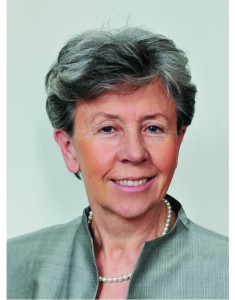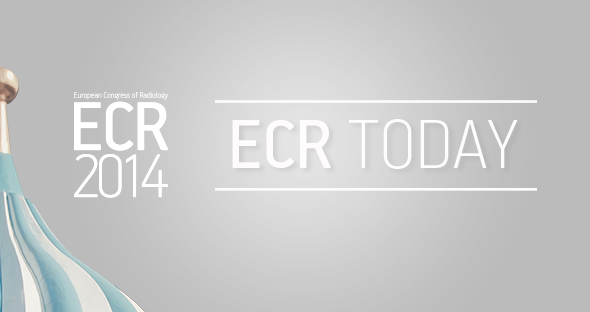Rising Stars exposes students to “the charms of radiology,” says former ECR President
ECR Today spoke with Professor Małgorzata Szczerbo-Trojanowska, from Lublin, Poland, patron of the Rising Stars programme.
ECR Today: The Rising Stars programme is under your patronage this year. What motivated you to take on this role?
Malgorzata Szczerbo-Trojanowska: Medical students and residents will create the shape of radiology in the future. Therefore, those of us who care for our specialty should make an effort to encourage the best, brightest and most enthusiastic students to choose diagnostic imaging as their professional career.
I am very pleased to be involved in the preparation of the Rising Stars programme, which aims to create an interesting educational agenda for students and to encourage them to actively participate in the congress sessions specifically designed for them.

Professor Małgorzata Szczerbo-Trojanowska is Head of the
Department of Interventional Radiology and Neuroradiology at the
Medical University in Lublin, Poland. She served as ECR Congress
President in 2010.
I think this programme is a very important initiative of the European Society of Radiology and the ECR. Having been an academic teacher for many years, I am aware of the great significance of undergraduate education. It has always been my aim as chairperson of the radiology department at my university to offer attractive forms of radiology teaching and to expose students to the charms of radiology from the early years of their education. This is the way to raise their interest in this specialty and get them involved in radiology research. It is in the best interest of the future of radiology. So when I was offered to take patronage of the Rising Stars programme, I didn’t hesitate for even a second.
ECRT: Why should a medical student or radiology trainee take part in this programme?
MST: The European Congress of Radiology, one of the world’s leading radiological meeting, offers medical students and residents a unique opportunity to see the greatest scientists, practitioners, lecturers and teachers present some fascinating achievements of modern radiology. There are also many chances to learn the state of the art in a wide variety of imaging methods for a plethora of diseases, and to find answers to complex problems of contemporary medicine provided by world-renowned experts. Participation in the ECR shows the importance of radiology in patient care, its great impact on other areas of medicine, and its relevance in the progress of medicine.
By taking part in the Rising Stars programme, medical students, radiology trainees and radiography trainees have an opportunity to give a presentation on the results of their own research work and opinions, or ideas, related to medical studies. Visiting the ECR technical exhibition is always an exciting and stimulating experience, providing a unique opportunity to become acquainted with cutting-edge technologies and new solutions.
The congress is also an excellent platform for young people to meet peers and colleagues from various continents and countries, and establish friendships that last a lifetime. The special dedicated lounge and the wonderful Rising Stars party will allow the participants to meet new friends.
ECRT: What do you think of the topics of the sessions?
MST: As always the topics were very carefully selected. This year four new topics for student scientific sessions were chosen: awareness of the role of radiology in medicine among medical students and radiographers-in-training, multiple-choice questions (MCQ), oral exams, ‘My educational student project at university’, and ‘My first medical scientific work’. The number of submitted papers surpassed 160, which proves that the topics were attractive to the students. We were also pleased to see that the quality of the abstracts was very good. The best of the best were chosen for the congress presentations; five papers for each session.
The educational basic sessions are dedicated this year to cardiac radiology, neuroradiology and oncologic imaging.
As an extension of the programme, we will offer case-based diagnosis training on Monday afternoon. Training will consist of two sessions, which will be divided by a short interlude. The sessions, which were prepared by two excellent lecturers, Dr. Soraya Robinson and Prof. Klaus Friedrich, are aimed mainly at residents and focus on case-based learning.
ECRT: What do you think of the quality of the students’ presentations?
MST: Judging from the very well prepared abstracts, I assume that the presentations will also be excellent. Last year, I chaired two sessions and I remember the very high quality of the presentations’ contents, structure and slides, and the excellent language, timing and performance. It was really a difficult task to select the best paper of the session. It is worth mentioning that the discussions following each presentation were educational and mature, and proved the authors’ profound knowledge of the topics.
ECRT: How relevant is it to offer peer-teaching ultrasound workshops for students?
MST: Many student congress participants showed interest in ultrasonography in the past. For those who have already had training in ultrasonography, workshops are an excellent chance to learn and benefit from contact with experts in this field. For those who have never used this imaging modality yet, it is an exciting experience showing the power of this most popular diagnostic tool. I am sure, based on many examples, that a lifelong interest in a particular area of radiology can be initiated by a single meeting with a brilliant educator.
ECRT: Do you have any advice for residents and medical students in general? Why should students choose radiology as a specialty?
MST: I would encourage medicalstudents to choose radiology because it is the most dynamically evolving discipline in the whole area of medicine. Accurate and early diagnosis is vital to successful treatment. Radiologists are, nowadays, the key players in the management of patients. Imaging departments are the fastest growing sector in medicine and will remain so in the future. I would advise students and radiology residents to expand their knowledge beyond imaging modalities to understand the clinical background and relevance of radiological diagnosis and treatment. This can be achieved by close cooperation with medical specialists from other disciplines. Those who would like to be involved not only in the diagnostic part, but also actively participate in treatment can specialise in interventional radiology, which offers a wide and rapidly expanding range of minimally invasive treatment methods.
I would personally encourage students and residents to engage in academic careers and research. Scientific work is demanding, but it stimulates personal development and, at the same time, gives tremendous satisfaction. Actively participating in research in the discipline you have chosen has this exciting
feeling of contributing to its further development.


